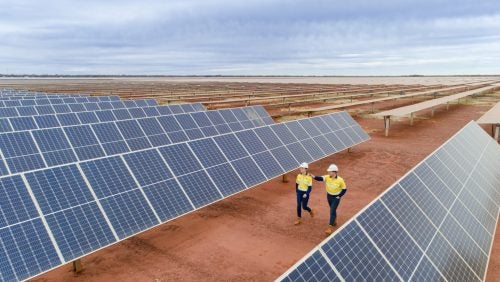Show Me the Money: Lessons from the New Renewable Energy Capital of the World
October 18, 2022 by Jesse Valente

Two engineers in safety gear and hard hats walk through a field of solar panels. https://www.pv-magazine.com/2021/12/16/alinta-switches-on-australias-largest-remote-solar-farm/
Queensland, Australia recently announced a renewable energy plan that makes it a model for community-backed public-private partnerships in the renewable sector. Backing from multiple levels of government, public appetite for renewable energy, and industry desire to capitalize on renewables have combined to turn climate pledges into tangible results. Queensland Premier Annastacia Palaszczuk calls it “one of the biggest announcements our government has ever made.”[1] Several key lessons can be learned from Queensland for any state, country, or locality hoping to mirror its successes.
Premier Palaszczuk announced a plan to convert the state’s coal-fired power plants to renewable hubs by 2035.[2] More than just a pledge, the project is backed by A$62 billion ($40 billion US).[3] The total funding mix is expected to include money from federal, state, and private sources.[4] However, “industry has been leading in the conversation about renewable energy,” according to Maggie McKeown of the Queensland Conservation Council.[5] Queensland demonstrates the importance of having legitimate financial backing to support any climate pledge. Similar projects in the future should be sure not to ignore potential funding sources from multiple areas.
This new funding will provide the resources needed to ensure that Queensland will source 80% of its energy needs from renewables by 2035.[6] This is an increase from the 21% figure today, replacing the coal that currently supplies 75% of Queensland’s energy.[7] To assuage fears of blackout from too swift an abandonment of coal, the coal-fired stations will be kept functional as backup until 2035.[8] The plan is expected to cut greenhouse gas emissions from Queensland’s energy sector by 90%.[9] The dramatic shift in energy sourcing in Queensland is essential to meeting its carbon neutrality goals. Although it may seem counterintuitive, a crucial aspect of this decision is the conservative approach of keeping coal-fired stations functional until 2035. The continued functionality of coal plants will help avoid blackouts and the bad press they would bring the energy transition.
Key to Queensland’s plan is treating the community as an important stakeholder. The “community appetite” for renewables is high in Queensland, and this plan helps to meet that appetite.[10] This appetite is well-founded since this new plan is expected to lower household power prices by A$150 and small business prices by A$1495.[11] Additionally, it is expected to create 100,000 jobs, with 95% of the investment going to the local community.[12] This job creation comes in addition to A$150 million to help transition affected coal workers to new jobs.[13] According to Premier Palaszczuk, funds will be provided for “reskilling, transfer to new opportunities and advice on future career pathways.”[14] Any plans that hope to utilize the model in Queensland need to consider the community as an essential stakeholder at all stages of project development.
Queensland’s renewable energy plan provides an important model to any government hoping to accomplish something similar. There are three key takeaways. First, any similar strategy should be sure to engage multiple sources for possible funding. Second, contingencies should be in place to avoid issues that may arise if the project doesn’t go as planned. Third, government and industry should treat the community as an essential stakeholder and consider community needs. The lessons from Queensland are valuable and deserve consideration in any future large-scale, government-backed renewable energy project.
[1] Tobias Jurss-Lewis, Queensland government set to unveil major investments along with 10-year energy plan, ABC News (Sep. 27, 2022), https://perma.cc/TH8A-Y643.
[2] Lewis Jackson, Australian state unveils $40 bln clean energy plan to slash reliance on coal, Reuters (Sep. 28, 2022), https://perma.cc/FQL8-CX98.
[3] Id.
[4] See Mark Ludlow, Queensland to cut off coal power by 2035, Australian Financial Review (Sep. 28, 2022), https://perma.cc/7CVG-2QNN.
[5] Jurss-Lewis, supra note 1.
[6] Jackson, supra note 2.
[7] Ludlow, supra note 4.
[8] See Ludlow, supra note 4.
[9] Jackson, supra note 2.
[10] See Jurss-Lewis, supra note 1.
[11] See Ludlow, supra note 4.
[12] Ludlow, supra note 4.
[13] Ludlow, supra note 4.
[14] Ludlow, supra note 4.

